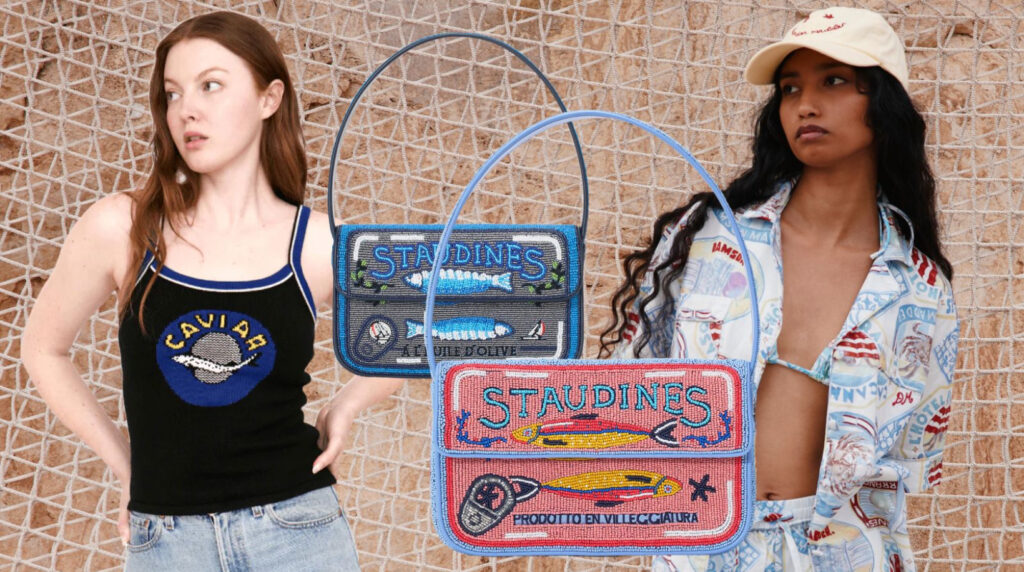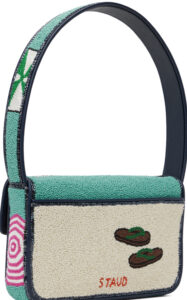


In the ever-churning tide of seasonal fashion, where coastal grandmother and tomato girl once ruled, a new maritime muse has emerged from the pantry: the tinned sardine. Once tucked away behind ceramic tiles and dusty netting, this pantry staple has become the unlikely icon of summer 2025 fashion. Sardines, anchovies, oysters, and mussels—rendered in watercolor, enamel, and metallic leather—now adorn handbags, hemlines, and even haute couture runways.
Leading the charge in this delightfully briny aesthetic is Staud, whose cult-favorite Tommy beaded bag has been reimagined as the “Staudine”—a glitzy, sardine tin-inspired evening bag that has sparked equal parts obsession and affection across social media feeds and wedding guest lists.
It Started with a Glint of Gold: From Bottega to Beaded Irony
The seeds of the tinned fish trend were planted in 2022, when Matthieu Blazy unveiled his inaugural collection for Bottega Veneta. Among the quiet storm of craftsmanship and artisanal know-how, one accessory made headlines: the Sardine Bag. With a sculptural gold fish handle and a subdued leather body woven in the maison’s signature intrecciato style, the bag was equal parts irony and reverence—a nod to utility, to European groceries, and to fashion’s growing appetite for the surreal.
At the time, critics likened the piece to Dali meets Aperitivo Hour. But what began as a witty runway statement soon became an aesthetic lodestar. It paved the way for other designers to follow, not by copying its silhouette, but by leaning into its gastronomic symbolism.
Enter the Staudine: Sardines Go Playful and Personal
Few designers are as fluent in playful irony as Sarah Staudinger, founder and creative director of Staud. Her accessories—especially the now-iconic Tommy bag—have long held cult status for their unapologetic kitsch and intricate beading. They blend LA irreverence with downtown polish, serving up storytelling in sequins and nylon mesh.
In summer 2024, Staud debuted a Tommy variation unlike any other: the Staudine. With shimmering beads forming a sardine tin label, complete with fish graphics and metallic accents, it was a literal representation of the phrase “packed like sardines”—but chic.
For Shawn Wallace, a finance professional based in New York City, the bag was an instant yes.
“I love seeing them come out with new colors and designs every few weeks. I’ve had a bit of an addiction, if I’m being honest,” Wallace told Marie Claire. When the Staudine appeared in her feed, she purchased it within minutes and brought it to weddings in Italy and France. “It ended up being a total hit,” she said.
And Wallace is not alone. TikTok testimonials, Instagram reels, and Reddit threads all echo the same story: the Staudine doesn’t just complete an outfit—it starts conversations.
From Aisle to Atelier: The Rise of Sardinecore
What makes the tinned fish motif so appealing in 2025? Part of its charm lies in its versatility across aesthetics. There is no singular way to dress like a sardine—some lean into nautical nostalgia, others into ironic elegance.
The Visual Language of Sardinecore
- Color palettes often feature oceanic hues: navy, coral, seafoam, and oyster pearl.
- Prints range from retro fish illustrations to hyperrealistic tin labels.
- Textures include scale-like sequins, glossy enamel, and metallic foils.
- Silhouettes remain breezy—caftans, A-line skirts, wide-leg trousers, tunics—all designed to evoke the Mediterranean breeze and slow-living ethos.
Designers such as Rachel Antonoff, Damson Madder, and Lisa Says Gah have embraced the aesthetic full tilt. Rachel Antonoff, known for her whimsical storytelling through clothing, released a two-piece set in early 2025 covered in vibrant mackerel and mussels—watercolored in painterly swaths of pink, orange, and aqua.
British label Damson Madder recently debuted a silk wrap dress with hand-embroidered oysters on the hem and a matching sardine-print scarf. Fast-fashion giants like Zara and H&M have followed suit, albeit more commercially, with sardine-printed camisoles, clamshell earrings, and fishnet-inspired knitwear.
Even J.Crew, that bastion of East Coast prep, has gone in on the trend, with T-shirts bearing the graphic of vintage sardine tins, emblazoned with mock-French typography and sun-bleached accents.
Why Sardines, Why Now? A Cultural and Aesthetic Context
Fashion has always used food to tell stories—about class, desire, geography, and even humor. But tinned fish—specifically sardines and anchovies—occupy a unique cultural niche.
Aesthetic Appeal
Their packaging is beautiful: metallic, illustrated, and collectible. Sardine tins are tiny masterpieces of vintage design, with brand identities that vary by country and region. In Lisbon, they are bold and carnival-like; in Marseille, they whisper Belle Époque charm. Designers tap into this lineage as both nostalgia and novelty.
Sustainability and Semiotics
The trend also dovetails with a growing consumer interest in sustainable luxury. Sardines are among the most eco-friendly proteins, requiring minimal resources and offering maximal nutrition. In a climate-conscious cultural moment, referencing this humble yet sustainable food aligns fashion with subtle advocacy.
Irony and Play
Finally, sardinecore is funny—and in an era of climate dread, economic precarity, and algorithmic sameness, fashion’s sense of humor matters. As New York Times critic Vanessa Friedman recently noted, “The best accessory today may not be a status symbol—but a punchline.”
The Accessorized Plate: Bags, Jewelry, and Beyond
As sardine prints flood dresses and co-ords, accessories have exploded with edible motifs:
- Sardine earrings made from hand-poured resin by indie brands like Picnic Parade.
- Oyster clutches by luxury label Luar, with a faux pearl inside.
- Fish-scale headbands, sea glass bangles, and clam-shell shoes.
And the pièce de résistance: the “raw bar” necklace, a maximalist piece featuring silver shrimp, gold oyster shells, and anchovy charms, first spotted on a stylist during Paris Fashion Week.
Critiques and Ironic Backlash
As with all trends that go mainstream quickly, sardinecore has begun to receive its share of pushback.
Some critics argue that the trend verges on costumery, reducing Mediterranean culture to a series of fish jokes. Others express concern about over-commercialization, especially when indie artisans are outpaced by fast-fashion reproductions.
There are also questions of inclusivity. While the imagery is rich and layered, some worry that sardinecore may feel alienating to people with allergies, dietary taboos, or cultural detachment from seafood aesthetics.
Still, defenders of the trend argue that symbolism need not be literal. It’s not about eating sardines. It’s about celebrating whimsy, craftsmanship, and an era where fashion offers joy through surprise.
What’s Next: Shelf Life and Expansion
Will sardinecore survive into autumn? Possibly. Already, we’re seeing Fall/Winter previews that extend the motif beyond fish into the full charcuterie board. Think: salami-print scarves, brie-shaped purses, baguette-button jackets.
Meanwhile, Staud has teased a new capsule that features “The Caponata Bag”—a beaded eggplant-and-olive tin inspired by Sicilian pantry staples.
It’s clear the trend isn’t just about summer, but about elevating the everyday, and transforming the mundane into objects of aspiration and irony.
Brine and Beauty in the Era of Sardinecore
Tinned fish might once have belonged to the utilitarian pantry or the bachelor’s shelf, but in 2025, they are muses. As motifs, they’re delightfully strange. As accessories, they’re bold. As symbols, they encapsulate a wider cultural longing: for Mediterranean summers, for analog beauty, for the strange poetry of objects we overlook.
Whether it’s the Staudine bag glittering at a Tuscan wedding, a co-ord printed with oysters slinking through a rooftop party, or a sardine tin tee at a beach bonfire, this trend is more than just a moment. It’s a mood.
A little salty, utterly stylish, and packed with personality.
No comments yet.








